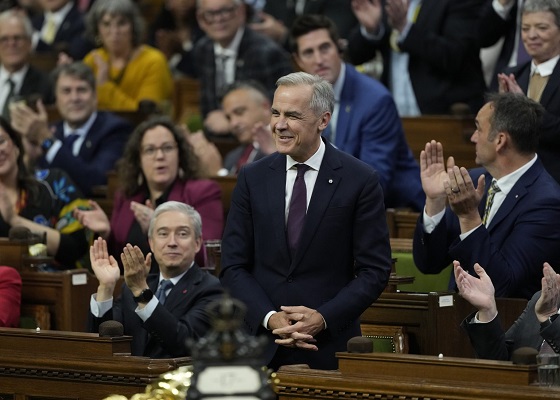Business
Big Tech’s Sudden Rush Into Nuclear Is A Win-Win For America


From the Daily Caller News Foundation
By David Blackmon
The U.S. power-generation sector has been hit in recent weeks with story after story about Big Tech firms entering into deals with power providers or developers to satisfy their electricity needs with nuclear generation.
Here are some examples:
—In mid-October, Google said it had entered into an agreement to purchase power for its data center needs from Kairos Power, a developer of small modular reactors (SMRs).
—A couple of weeks earlier, Microsoft and Constellation completed a deal that would involve the restart of Unit 1 at the Three Mile Island facility in Pennsylvania to power that company’s needs.
—On Dec. 3, Meta issued a request for proposals to nuclear developers to provide up to 4 gigawatts (GW) of electricity to power data centers and AI no later than the early 2030s.
—Perhaps the most extensive development of all came two days after Google’s announcement, when Amazon announced it has entered into deals to support the development of Small Modular Reactors (SMRs) with three developers in three different regions of the country.
So, what’s going on here? Aren’t all these Big Tech companies supposed to be totally bought into the climate-alarm narrative, a narrative that claims wind and solar are the only real “clean” energy solutions for power generation? Aren’t we constantly bombarded by boosters of those non-solutions that they are able to reliably provide uninterrupted electricity if backed up by stationary batteries?
Certainly, that has been the case in the past — few corporations could hope to match the volume of virtue signaling about green energy we have seen from these tech companies in recent years. That was all fine until, apparently, the AI revolution came along.
AI is an enormous power hog, one that these and other Big Tech firms must now rapidly adopt to remain competitive.
The trouble with AI and the data centers needed to make it go is that it requires the reliable, constant injection of electricity 24 hours a day, 7 days a week, 365 days every year. While these Big Tech firms would no doubt love to be able to virtue signal about sourcing their power from wind and solar backed up by enormous banks of batteries, each and every one of them has assessed that option and realized it cannot reliably fill their needs.
Thus, the recent rush to nuclear. After all, once they’ve been built and placed into service, nuclear reactors are a very real zero emissions power source. And unlike wind and solar, nuclear plants do not have to be backed up by an equal amount of generation capacity provided by another fuel, consisting most often of natural gas plants. Nuclear reactors are basically the Energizer Bunnies of power generation: They just keep going and going.
Another big advantage nuclear brings over renewables is the avoidance of the need to invest in massive new transmission networks. This is especially true of SMRs, which can be installed directly adjacent to the contracting data centers. By contrast, wind generation installations must be located in areas where the wind reliably blows. Such areas are often hundreds of miles away from big demand centers, as has been the case in Texas.
Where solar is concerned, the provision of multiple gigawatts (GWs) of generation capacity can require the condemnation of hundreds of acres of land, often thousands. The stationary battery centers for 1 GW of solar or wind would require another large swath of land to be condemned. By contrast, the land footprint for a pair of 500 megawatt (MW) SMRs would amount to no more than a few acres.
Where the deal between Microsoft and Constellation is concerned, sourcing power from an older generation nuclear plant like Three Mile Island will involve interconnecting into an already extant transmission system, though some upgrades and extensions will no doubt be required.
This sudden rush to nuclear by some of the largest companies in the country will benefit all Americans. The massive infusion of capital will accelerate development of SMRs and other advanced nuclear tech, pressure policymakers to modernize antiquated nuclear regulations, and to streamline Byzantine permitting processes that currently inhibit all forms of energy development.
It is a win-win situation for all of us.
David Blackmon is an energy writer and consultant based in Texas. He spent 40 years in the oil and gas business, where he specialized in public policy and communications.
Artificial Intelligence
Google denies scanning users’ email and attachments with its AI software

From LifeSiteNews
Google claims that multiple media reports are misleading and that nothing has changed with its service.
Tech giant Google is claiming that reports earlier this week released by multiple major media outlets are false and that it is not using emails and attachments to emails for its new Gemini AI software.
Fox News, Breitbart, and other outlets published stories this week instructing readers on how to “stop Google AI from scanning your Gmail.”
“Google shared a new update on Nov. 5, confirming that Gemini Deep Research can now use context from your Gmail, Drive and Chat,” Fox reported. “This allows the AI to pull information from your messages, attachments and stored files to support your research.”
Breitbart likewise said that “Google has quietly started accessing Gmail users’ private emails and attachments to train its AI models, requiring manual opt-out to avoid participation.”
Breitbart pointed to a press release issued by Malwarebytes that said the company made the changed without users knowing.
After the backlash, Google issued a response.
“These reports are misleading – we have not changed anyone’s settings. Gmail Smart Features have existed for many years, and we do not use your Gmail content for training our Gemini AI model. Lastly, we are always transparent and clear if we make changes to our terms of service and policies,” a company spokesman told ZDNET reporter Lance Whitney.
Malwarebytes has since updated its blog post to now say they “contributed to a perfect storm of misunderstanding” in their initial reporting, adding that their claim “doesn’t appear to be” true.
But the blog has also admitted that Google “does scan email content to power its own ‘smart features,’ such as spam filtering, categorization, and writing suggestions. But this is part of how Gmail normally works and isn’t the same as training Google’s generative AI models.”
Google’s explanation will likely not satisfy users who have long been concerned with Big Tech’s surveillance capabilities and its ongoing relationship with intelligence agencies.
“I think the most alarming thing that we saw was the regular organized stream of communication between the FBI, the Department of Homeland Security, and the largest tech companies in the country,” journalist Matt Taibbi told the U.S. Congress in December 2023 during a hearing focused on how Twitter was working hand in glove with the agency to censor users and feed the government information.
If you use Google and would like to turn off your “smart features,” click here to visit the Malwarebytes blog to be guided through the process with images. Otherwise, you can follow these five steps courtesy of Unilad Tech.
- Open Gmail on Desktop and press the cog icon in the top right to open the settings
- Select the ‘Smart Features’ setting in the ‘General’ section
- Turn off the ‘Turn on smart features in Gmail, Chat, and Meet’
- Find the Google Workplace smart features section and opt to manage the smart feature settings
- Switch off ‘Smart features in Google Workspace’ and ‘Smart features in other Google products’
On November 11, a class action lawsuit was filed against Google in the U.S. District Court for the Northern District of California. The case alleges that Google violated the state’s Invasion of Privacy Act by discreetly activating Gemini AI to scan Gmail, Google Chat, and Google Meet messages in October 2025 without notifying users or seeking their consent.
Business
Is affirming existing, approved projects truly the best we can do in Canada?

From Resource Works
For major projects, what is old is new again
Prime Minister Mark Carney’s second wave of “nation-building projects” sounds transformative: six new energy and mining proposals, plus a northern corridor, added to the first tranche unveiled in September, and included in the freshly passed federal budget for the fiscal year.
Together, Ottawa says, they amount to more than $116 billion in investment and are central to “realizing Canada’s full potential as an energy superpower.” That is the pitch in the federal news release.
Look closely, though, and a different picture emerges. For major projects, what is old is new again. Almost every file now being “fast-tracked” was already on the books, sometimes for a decade or more.
The new referrals to the Major Projects Office (MPO) are all familiar: the Nisga’a-led Ksi Lisims LNG terminal on B.C.’s north coast; BC Hydro’s North Coast Transmission Line; Canada Nickel’s Crawford project near Timmins; Nouveau Monde Graphite’s Matawinie mine north of Montréal; Northcliff’s Sisson tungsten project in New Brunswick; and the Inuit-owned Iqaluit Nukkiksautiit hydro project in Nunavut. The “Northwest Critical Conservation Corridor” in B.C. and the Yukon is added as a long-range concept.
Long timelines and longstanding obstacles
None of these is a fresh idea. As the Globe and Mail notes in a project-by-project rundown, Ksi Lisims has been in development for years and already faces two Federal Court challenges from nearby First Nations and opposition from Wet’suwet’en hereditary leaders who fought Coastal GasLink. The North Coast Transmission Line was identified in 2023, with B.C. legislation to fast-track it and term-sheet co-ownership deals with First Nations already in place. The Sisson mine has been stalled at the pre-construction stage for more than a decade, despite earlier approvals and new public money to update its feasibility study.
Iqaluit hydro is hardly a novelty either. As Globe reporting shows, dam concepts near the city have been studied since the mid-2000s, with the current Inuit-owned proposal building on that earlier work and backed by federal engineering funds. The Crawford nickel project was acquired in 2019 and has spent years lining up investors and a complex financing stack, documented in both CBC and Financial Post coverage. Matawinie received its Quebec authorization in 2021, has an impact-benefit agreement with the local Atikamekw Nation and now enjoys federal price-floor guarantees on graphite.
The first tranche, announced in September, follows the same pattern. LNG Canada Phase 2 in Kitimat, new nuclear at Darlington, Contrecoeur container capacity at the Port of Montréal, McIlvenna Bay in Saskatchewan and the Red Chris expansion in B.C. were all in various stages of planning long before Carney entered office. The MPO is not inventing a new project pipeline; it is trying to accelerate the one Ottawa already had.
Acceleration is the point — and industry welcomes it
Acceleration is, to be fair, the point. The Calgary-based MPO, led by former Trans Mountain head Dawn Farrell, is designed to run permits in parallel, not one after another, and to coordinate financing through bodies like the Canada Infrastructure Bank and Canada Growth Fund. Farrell told CBC that work which might have taken “five or six more years” could be cut to roughly two. In a country where large projects regularly die of regulatory exhaustion, that is significant.
Industry likes the signal. Canada Nickel CEO Mark Selby says MPO referral “puts us in the fast lane,” even without the more controversial “national interest” label in Bill C-5 that would allow cabinet to set aside parts of the Fisheries Act, Species at Risk Act or Impact Assessment Act. Inuit proponents of the Iqaluit project welcome Carney’s description of their hydro plan as a breakthrough for Arctic sovereignty, replacing millions of litres of diesel.
But a superpower strategy this is not
Still, if this is what becoming an “energy superpower” looks like, it is a modest start.
Notably absent from Carney’s list is any new oil pipeline. Alberta Premier Danielle Smith has spent months pushing a concept for a bitumen pipeline from the oil sands to the northern B.C. coast, doing provincial groundwork in the hope a private proponent will one day take it over. A BBC report sets out the feud with B.C. Premier David Eby, who dismisses the idea as “fictional” and “political” and insists no company wants it, accusing Smith of jeopardizing B.C.’s LNG ambitions. Smith has called that stance “un-Canadian.”
Western frustration is growing. In the National Post, Whitecap Resources chief executive Grant Fagerheim warns of “fury from Alberta and Saskatchewan” if a pipeline to tidewater is never prioritized and argues producers are tired of a U.S.-dominated system where Canadian barrels sell at a discount while others capture the margins. He favours an energy corridor carrying oil, gas, power and rail, not just more rhetoric about nation-building.
Northern ambitions lag behind rhetoric
Another gap is the North. The Indigenous-led Arctic Gateway partnership, Manitoba and Ottawa are already spending heavily on the Hudson Bay Railway and planning new storage and loading systems to expand the Port of Churchill for grain, potash, critical minerals and Arctic resupply. Carney talks up a “huge host of opportunities” in northern Manitoba, but Churchill sits only on the MPO’s lower-profile “transformative strategies” list, with a full plan now pushed out to 2026.
Meanwhile, the one project that has fundamentally shifted Canada’s oil export position is the long-delayed Trans Mountain expansion. As Resource Works points out, TMX now sends diluted bitumen from Burnaby to Asia, shrinking the old “captive discount” and giving Canada genuine leverage in global markets. But TMX predates Carney’s government by more than a decade and only exists because Ottawa nationalized a struggling private pipeline to get it built.
Evolution, not revolution
Carney’s major-projects push is real, and for the companies involved, the prospect of faster permits and clearer federal backing is very good news. Yet for a government that talks about mobilizing a trillion dollars and remaking Canada as an energy superpower, the current list is evolutionary rather than revolutionary. For now, Ottawa is mostly trying to build what was already on the drawing board. The tougher choices on pipelines, ports and interprovincial trade still lie in front of it.
Headline photo credit to THE CANADIAN PRESS/Adrian Wyld
-

 Alberta2 days ago
Alberta2 days agoPremier Smith explains how private clinics will be introduced in Alberta
-

 Censorship Industrial Complex2 days ago
Censorship Industrial Complex2 days agoUK Government “Resist” Program Monitors Citizens’ Online Posts
-

 Business2 days ago
Business2 days agoUS Supreme Court may end ‘emergency’ tariffs, but that won’t stop the President
-

 Bruce Dowbiggin2 days ago
Bruce Dowbiggin2 days agoElbows Down For The Not-So-Magnificent Seven: Canada’s Wilting NHL Septet
-

 International2 days ago
International2 days ago“The Largest Funder of Al-Shabaab Is the Minnesota Taxpayer”
-

 Alberta2 days ago
Alberta2 days agoAlberta introducing dual practice health care model to increase options and shorten wait times while promising protection for publicly funded services
-

 International2 days ago
International2 days ago50 of the 315 students and 12 staff abducted from Catholic school in Nigeria last week have escaped
-

 espionage1 day ago
espionage1 day agoSoros family has been working with State Department for 50 years, WikiLeaks shows






